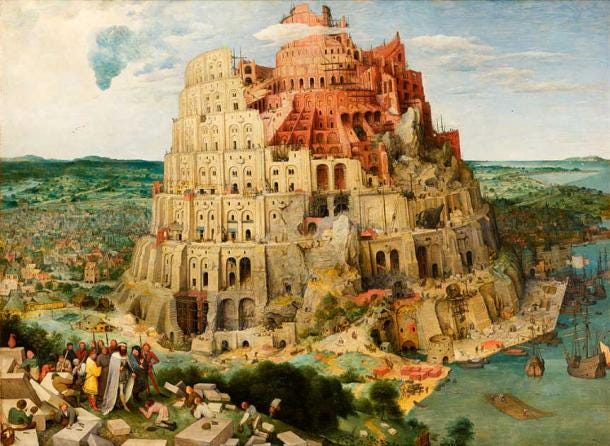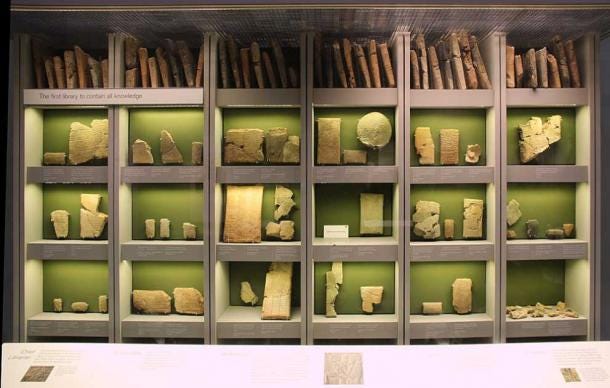Featured Article - Gateway to the Heavens: The Assyrian Account of the Tower of Babel
Issue 20
Author: Petros Koutoupis
Originally published on Ancient Origins (11 October, 2014; current publication date is inaccurate) and in Biblical Origins: An Adopted Legacy (2008) but revised.

The story of the fabled Tower of Babel from the Book of Genesis has come to inspire artists throughout history and to symbolize the idea of human ambition.
The Biblical Story of the Tower of Babel
The story of the construction of a tower in Babel, which resulted in the confounding of language, has perplexed modern scholars for decades. The Book of Genesis tells of a time in which all of the world’s population migrated eastward to the plain of Shinar. Shinar, the Hebrew for “[land of the] two rivers,” is considered by most to be what the Akkadians referred to as Shumer or Sumer, known today as Mesopotamia, or modern-day Iraq.
The Hebrew etymology is most likely referring to the rivers of the Tigris and Euphrates. In fear of being scattered across the whole face of the earth, the inhabitants of the plain decided to build a city and also a tower to reach the heavens. This city would be referred to as Babel (Akkadian: bab-ili or “gate of God”) which was also a play on the Hebrew word balal or “to confuse” (i.e. the language). According to the Old Testament, man was then punished for building this Tower of Babel through the creation of language, designed to create division amongst mankind.
Tower of Babel Excerpt within Genesis
The following excerpt is from the Jewish Publication Society translation of Genesis 11:
“1 And the whole earth was of one language and of one speech.
2 And it came to pass, as they journeyed east, that they found a plain in the land of Shinar; and they dwelt there.
3 And they said one to another: ‘Come, let us make brick, and burn them thoroughly.’ And they had brick for stone, and slime had they for mortar.
4 And they said: ‘Come, let us build us a city, and a tower, with its top in heaven, and let us make us a name; lest we be scattered abroad upon the face of the whole earth.’
5 And the Lord came down to see the city and the tower, which the children of men builded.
6 And the Lord said: ‘Behold, they are one people, and they have all one language; and this is what they begin to do; and now nothing will be withholden from them, which they purpose to do.
7 Come, let us go down, and there confound their language, that they may not understand one another’s speech.’
8 So the Lord scattered them abroad from thence upon the face of all the earth; and they left off to build the city.
9 Therefore was the name of it called Babel; because the Lord did there confound the language of all the earth; and from thence did the Lord scatter them abroad upon the face of all the earth.”
Searching for the Tower of Babel: Excavating at Nineveh
While most of us are familiar with the Hebrew account of the dispersal of peoples and the introduction of new languages, archaeology has shown that the concept of a spreading of tongues is not as unique as we believe. We must divert our attention to George Smith, the very same George Smith who first translated the Epic of Gilgamesh in the 19th century, and provided the world with the earliest documented reference to the great flood .

Following his translation of Gilgamesh, Smith was sent to the site of Nineveh where he was to continue excavations in the hopes of unearthing additional inscriptions that paralleled or showed some relation to the Old Testament. Archaeology at the time was a new science, founded on validating the writings of the Bible.
Discovery of Ancient Stories Which Inspired the Biblical Tower of Babel
Smith was fortunate, in that the excavation did yield additional tablets, from the Royal Library of Ashurbanipal, and upon further research he did actually discover a story likely to have inspired the Biblical account of the Tower of Babel. Catalogued and hidden in the inventory vaults of the British Museum , the fragmentary piece of text reads as follows:
“[…] them? The father […]
Of him, his heart was evil,
[…] against the father of all the gods was wicked,
[…] of him, his heart was evil,
[…] Babylon brought to subjection,
[small] and great he confounded their speech.
[…] Babylon brought to subjection,
[small] and great he confounded their speech.
Their strong place (tower) all the day they founded;
to their strong place in the night
entirely he made an end.In his anger also word thus he poured out:
[to] scatter abroad he set his face
he gave this? command, their counsel was confused
[…] the course he broke
[…] fixed the sanctuary”

George Smith provided a commentary to his translation briefly summarizing what the inscription meant to him, along with highlighting key words that emphasize the type of construction that took place.
“…we have the anger of the gods at the sin of the world, the place mentioned being Babylon. The building or work is called tazimat or tazimtu, a word meaning strong, and there is a curious relation, lines 9 to 11, that what they built in the day the god destroyed in the night.”
Key parallels are seen between the Biblical and Assyrian accounts, that is, that they both speak of mankind unified by a single language and building a tower, thus angering the gods, which resulted in the confusion of the language. The Assyrian account of the Tower of Babel, much like the other tablets found in the same collection, were most likely copies of older tablets. What inspired the Assyrian Babel and what was the original message conveyed? Much like its Hebrew counterpart, these questions continue to elude us.
Sources
Davidson, Benjamin. The Analytical Hebrew and Chaldee Lexicon. 11th ed. Peabody: Hendrickson Publishers, 2004. [Print]
JPS Hebrew-English Tanakh. Philadelphia: Jewish Publication Society, 2003. [Print]
Koutoupis, Petros. Biblical Origins: An Adopted Legacy. College Station: Virtualbookworm.com P, 2008. [Print]
Smith, George. The Chaldean Account of Genesis. London: Elibron Classics, 2005. [Print]


